Ah, the humble status LED. Just about every piece of home electronics, every circuit module, and anything else that draws current seems to have one. In the days of yore, a humble indicator gave a subtle glow from behind a panel, and this was fine. Then the 1990s happened, and everything got much much worse.
It’s Not The Technology, It’s How You Use It
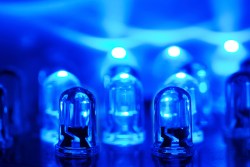
The 1990s brought us much good: Nirvana, Linux, and of course the blue LED. Much like “Teen Spirit”, the latter quickly fell into overuse: the technology rapidly became the sigil of all that was new and great, much to the ocular pain of the buying public.
This decision ranks up there for stupidity with other such questionable choices as hiring a rental car at the airport, or invading Russia in the winter. A status LED, most would agree, is there to indicate status. It need only deliver enough light to be seen when observed by a querying eye. What it need not do is glow with the intensity of a dying star, or illuminate an entire room for that matter. But, in the desperate attempts of product designers to appear on the cutting edge, the new, brighter LED triumphed over all in these applications.
The pain this causes to the user is manifold. The number of electronic devices in the home has proliferated in past decades, the vast majority of which each have their own status LED. Worse, many of these are used in the bedroom, be it laptops, phone chargers, televisions, or others. With the increased brightness of these indicators, many of which are on all the time, the average sleeping space is lit like a Christmas tree.
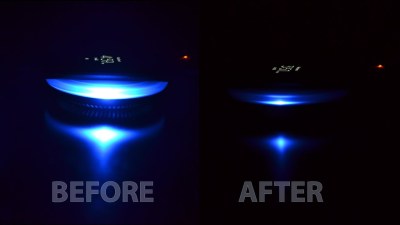
The fad of using blue LEDs for power indicators only makes this problem worse. The human eye features special receptors sensitive to blue light that are not only used for vision.These cells are also used to detect the blue light from the sky, coordinating our internal Circadian rhythms to the Earth’s day/night cycle. Exposure to artificial blue light can interfere with this system, with research suggesting it may have a negative effect on sleep cycles.
Part of the problem is that the majority of LEDs on the market now are efficient, high brightness designs. These parts get included in designs with little regard for their excessive light output simply because it’s easy to do so, or maybe the designers have just failed to update their standard resistor value choices.
The fact is, if I can see a bright glow on the ceiling because I left Caps Lock on before retiring for bed, that’s a problem. The same goes for phone chargers and laptop chargers too. I shouldn’t have to wrap a device in several layers of electrical tape to hide a light that should be little more than a dim glow to begin with. If the device is reliable enough, I probably don’t need to be looking at it anyway!
Doing It Right
Of course, we love blinkenlights, and good status LEDs do serve a purpose. They tell us that we’re composing an highly aggressive email with the scary big letters, that our charger is indeed receiving delicious AC current, or that our monitor is receiving power but isn’t really, properly turned on (okay seriously, who cares?). Crucial as they are, there’s no excuse for getting them so badly wrong. It’s important to lay out a few rules to guide their proper implementation and use.
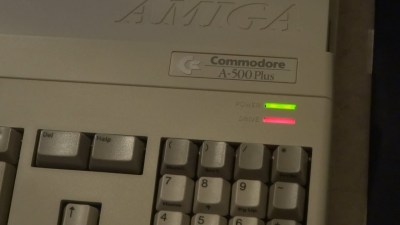
Excessive brightness should be avoided. As small LEDs can be easily dimmed with a simple resistor value change, there is no excuse for power or standby LEDs that light up a room. Instead, the level should be suited to typical use cases. 1980s home computers had no problems with excessively bright indicators, thus it is suggested that readings be taken from a sample of standard Amiga 500 power LEDs. The average value found should be the upper limit for power indicators on indoor electronic devices. It’s important to remember that you shouldn’t be looking at the power LED that often anyway, unless your hardware is highly unreliable. In that case, you have other problems.
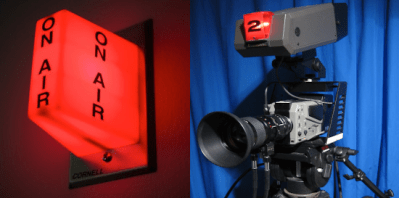
Colors should also be standardised, or at the very least, chosen with some kind of thought as to effective visual communication. While I marvel at the pretty pink LED on Nintendo’s DSi, we had previously long established red as the color of a recording light, and thus there is little reason to differ. If your hardware must have a standby LED (again, really?), make it red or orange. Power LEDs should universally be green. None of this “blue for on” nonsense – it’s just showing off. It wasn’t cool in 2001, and it isn’t cool now.
The purpose of status LEDs should also be questioned. Too many LEDs, or too many colors, can be confusing. A laptop battery charge LED should be a single color, to indicate charging – ideally green. If it’s orange and green, what does that mean, exactly? Charging, and fully charged? Fault, and charging? If a user has to look up a manual to determine the meaning of a status LED, you can likely do better.

Flashing should only be used where absolutely necessary. LEDs for hard drive and network activity should flash, as they indicate a constantly changing state. Mute LEDs on a mixing board should flash, because they’ll save noob techs when they can’t figure out why no sound is coming out. On the other hand, a standby LED on a television should never flash, because if the TV is off, it’s because nobody wants to pay attention to it.
Hopefully, these rules serve as a starting point for hardware designers in future. No longer will a charging pad, designed for a bedside table, bathe an entire room in an eerie blue glow. A TV will not blink incessantly, keeping houseguests awake as they try to sleep on the couch. With a few changes, we may all rest soundly, free from glaring visual distractions as we go about our daily lives. Of course, this is just the opinion of one grizzled engineer. Be sure to sound off in the comments.

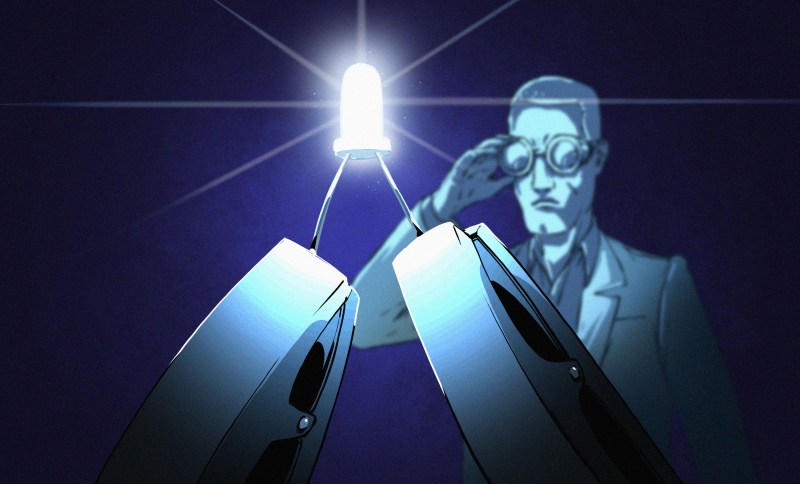















I agree totally. Except that blue leds were awesome in 2001.
Oh no you don’t!
Encourage the manufacturers to continue seeking brighter and brighter status indicators! Convince the marketing departments that bright is the new thin!
We need to keep research going towards higher and higher light output.
Don’t you want light sabers?!?!
Except for the ultraviolet flash light I bought at Walmart last week and the display light in a two watches, there are no blue LEDs in my home. The afore mentioned items, I don’t see them unless I activate them. The LEDs on my wireless router ar all green, I don’t notice them, unless I have to look at the device. I opened up a router that failed. The LEDS where at the rear edge of the board, with light pipes goin to the front panel. Given the difficulty in removing the light pipe , it would have been difficult to replace ant blue LED With another color. The caps lock key on my notebook computer has a blue LED. Given my habit of turning of that computer, when I wont be using it for several hour, it doesn’t present the issue contained in the post in this post
Use yellow highlighters on yellow post-it notes (or plain paper.) I usually cut out two small squares scribbled with the highlighters, Then take a hole punch and punch through black electrical tape to put on top.
The yellow ink will be triggered by the bright blue light, and the mixture will come out as a dimmer green.
The post-it note is helpful for initial alignment but the electrical tape keeps it there.
Piezo sound emitters are also way over used, IMHO. I have a digitally controlled space heater in my bedroom. Every button press emits a super loud, high pitched beep – it seriously makes me wince at every button press. To turn it on and set the temperature or timer function usually involves 3-6 button presses, each one just as painful and obnoxious on the ears as the last.
WHY THOUGH? The power, mode, and up/down buttons all have tactile feedback, in addition to an audible click as they are pressed. The 7-segment display changes with each button press. So WHY was this not enough feedback to the user? Because the rest of the house needs to know I’m turning on my heater or changing the set temperature?!?!
I finally took out the 6 screws holding the enclosure together, grabbed my needle nose pliers, and ripped that piezo off the PCB. I wished I had done it years ago. But now if I ever own an audibly obnoxious device in the future I wont hesitate to do the same to it, just as I have destroyed or covered obnoxiously bright and pointless “status” LEDs.
I totally agree. Blue LEDs are a scourge on society.
I measure excessive brightness by counting the number of fabric band-aids needed to reduce it to an appropriate bedroom level. Band-aids are much more convenient when I’m in my boxers in the middle of the night, as they are in the bathroom cabinet and not downstairs in the cold garage. Most things just need one. Some need two. I have a component to HDMI adapter that needed four. That was ridiculous. :O
Why the hell do we need these BLINDING over bright lights as head lights that don’t throw a beam of light on the roadway but a blinding glaring light in our eyes from on coming vehicles and then the morons put more lights on that are for off road use ONLY.
Great article, but you forgot the most important part!!
Use colors that everybody can distinguish. Why do people more and more use colors that are hard to tell apart when you have red-green vision deficiency?
Don’t use a green that is close to red, use a blue green (cold), and a warm/intense red. Nothing mixed with yellow or orange.
Like with traffic lights. Though some of constructions sites are able to mess this up as well.
Comment section is very “Lit” 🤣👍
That said who thought putting RBG lights on computer memory a “kewl” thing? The fully brightness of selecting all white cooks the memory and causes crashes commonly. Was it Sales and Marketing because “the data”. I imagine the Hardware Engineers really hate them and the bosses guys. Thanks Corsair.
Very much so agree with this article; I hope designers everywhere heed this advice. The number of unreasonably bright LEDs I’ve taped over or removed is quite significant. Also, the blinking blue and white standby LEDs in particular…what were they thinking? I find black tape works well enough on dark surfaces, but for anything in a white enclosure I’ll use a penny or a few layers of aluminum foil under white electrical tape to make it less noticable.
I have a ‘Dometic’ brand refrigerator in a caravan, and it has bright blue LEDs for separately indicating mains power, 12V power, gas power AND a bar of LEDs for how cold it gets.
The amount of blue light it emits and lights up the whole caravan is really excessive and makes it very difficult to sleep. I made a cardboard cover to place over it and that’s better now. I intend to design a bespoke 3D printed one sometime.
„ in the desperate attempts of product designers to appear on the cutting edge“ don’t blame the designers, it was probably marketing who said “but mine must be brighter!”
Marketing people are indeed guilty It seems to me the phrase, “we could sell 15% more units if they looked sexier” “Use blue LEDs guys” make them read this article several times.
Black Marker or White Correction fluid, depending on the aesthetics, should serve well. If you want to diffuse the light, use small piece of paper and cello tape.
I was a product designer in the 80s to the early 00s and I totally agree. At first we really wanted a blue LED but they were unavailable or too expensive, so we had to make do with the other more available colors. I always tried to go minimal, but many of my products were used in industrial applications, so a warning light had to be noticed. For home use, it can be a bit more subtle!
20 years later, almost everything has blue lights and I end up putting tape over the display. If the device is in my bedroom it disturbs my sleep.
Back in the day I was in a car club and the cars we sported had the plain old Green status lights anywhere from tinted bulbs, LEDs and VFD. I had found using Red seethru plastic wrapping paper would dramatically change the Color, tint and brightness depending on how many layers was used. Three layers turned the Green VFD into White. I used this trick on several projects over the years. Cheap automotive window tint works wonders since I am a AV Integrator and most people don’t want to see bright lights from equipment in their theater rooms I can either slap it on the outside of the unit or if the customer is very anal about it I can take the front panel apart and put it inside to make it totally factory.
Also the status light in the logo of the xbox controller, had to put tape on it when playing at night.
Alternate fix: Rip out the perfectly good blue LEDs and use them to make a grow lamp on Veroboard.
Replace with red/orange/etc of the same size and it will work fine. I consider it my “Trademark” on machines here.
Fun fact: you can tell on a keyboard which ones have been in use by the fading relative to their
unused neighbours, and use it as a rough gauge of device age.
I have about 60 here which are on battery meters.
Remember folks: The purpose of all electronic devices is precisely to drive status LEDs. Otherwise it’s merely an electric circuit. Prove me wrong.
Speak not of this blinkenlights conspiracy to enslave microprocessors to the will of the fascist forces of bad lighting, the ill-lumen-nazis will get you.
So does the blue led indicate in or off? Why not a world standard? Green on red off blue standby????
This reminds me of a 12 band stereo graphic EQ I bought from Radio Shack a number of years ago. It had those super bright blue LEDs on all of sliders and for power, … It ended up sitting in the equipment rack in the entertainment cabinet right under the TV. In my defense I had no idea how bright or what color those suckers were until I had it in the rack and plumbed into the amp. Sitting under the TV they were so bright we could barely see what was playing. I really had know idea that evil sadists had taken over the audio equipment industry. I ended up tucking a piece of paper between the unit above it and itself and folding it down over the face of the EQ.
Unfortunately the unit was brighter and more stylish than it was well built. Nice sound and all but it only lasted a couple of years. For which our eyes gave thanks!
MPJa.com has sales on individual NeoPixel clones. They get down to about 20 cents a piece. The cheapest I’ve seen in low quantities. I usually buy 100 at a time when they are on sale. At 5v and even half brightness they give me spots. I’ve been using a pair combined with an ATmega/Arduino as a night light to experiment with lighting effects. It will light the whole room. Not bright enough to read by mind you but good enough to keep you from stumbling in the dark. For normal display I usually run them at quarter brightness or less. And I’ve seen these work well on 3v3, which of course dims them some.
They are bright enough that I have to take care with how I implement them. :-)
It’s great to see people weighing on this thread on behalf of CVD (colour blindness) sufferers, but I wanted to add my experience. PLEASE, PLEASE, PLEASE don’t use colour *only* to differentiate between states. I’m red/green colourblind and find it virtually impossible to differentiate between red/green/amber/orange LEDs. I can’t tell when my MacBook Pro or camera battery is charging or charged, I can’t tell the status of switchports on the Cisco ethernet switches I work with every day, I can’t tell if hard drives have failed from glancing at the front panel on our SAN gear.
The best use of an LED as a status indicator I’ve seen was on a Cisco voice gateway ethernet interface. LED off means no connection, 1 pulse per second is 10mb/s, 2 pulses is 100mb/s and 3 pulses is 1gb/s. Why they don’t use this as standard across all their kit I’ll never know.
Separate labelled LEDs for different statuses is preferred, but flashing patterns is acceptable if cost/space is an issue.
Also, almost every blue LED in my house has a strip of tape over it as they drive me nuts ¯\_(ツ)_/¯
For the love all that’s holy, THANK YOU!
This is something that cannot be said too often.
The most hated piece of equipment i had was a DVD player with back-lit buttons. Not a small light bulb with a faint glow pleasant to the eye as in the FM-tuner right next to it. Of course they had to use ULTRA BRIGHT blue LEDs. I dont know what kind of psychedelics they took that this was built into the final product.
Close to perfect IMO are car warning lights: If there is no problem, nothing lights up. But if there’s a problem a sharp and crisp pictogram is shown. You also get the severity of the error (red/yellow/green/blue).
I kinda missed green instrument cluster.
https://assets.bigcartel.com/product_images/132792963/a1.jpg
fwiw, red and green leds should never be used together on the same device since for a whole mess of people with colour blindness they are completely impossible to differentiate, so blue is probably the better option (if it’s not like a klieg light)
The cops here use lightbars stuffed with those ultrabright blue and red leds. I can barely see to safely get around them at night when they pull someone over on the side of the road. Completely blinded by them at night as I try to safely pass.
They started out with those here, but they seem to have reacted to complaints and toned them down a bit.
Even the modern XBOX One has a light on the remote that is so bright it’s distracting when using the device as a movie player. Still designer’s don’t bother to do things right, even at a company as large as M$.
Also this thread elsewhere, discussing aircraft cockpit light colours:
https://www.airliners.net/forum/viewtopic.php?t=1383325
Apart from anything else it explicitly cites CFR 25.1322 which is a (US) regulation.
I think that one thing which is universally agreed is that red equated to urgent trouble, which flies in the face of the tradition that a cockpit or bridge used red background illumination in an attempt to preserve crew’s night vision. Having red background light might have been OK during WW2 and the Cold War when all annunciator lights were white, but not once LEDs became pervasive in the ’90s.
MarkMLl
My HP docking station has the breathing led which is so slow I have to stare at it for a full second to see if it is on/off/or actually starting to boot after pushing the button. Drives me nuts.
Worst abuse of LED indicators I ever encountered was the Internet modem for a satellite provider. Four INCREDIBLY bright LEDs were shining through a ventilation grille, so you could not even tape them over! There should be a master dimmer for all these lights, so people can sleep nights.
A few years ago my friend’s bathroom spin brush stopped working. It was some cheap-ass Chinese knockoff of another item but its innards were wonky even by that low standard. The battery was NiCd so I assumed it was dead cells but nooooo. The indicator light was a bodged PCB in place of what was originally a single superbright LED. Said LED would run whether it was on or off so it would run down the battery. IIRC the PCB was a tiny SMT LED flasher but in this unit the flasher itself had lost its smoke. After realizing how effed up it was I simply clipped out the board and it worked.
Sometimes, explanations are puzzling, too : https://www.screencast.com/t/gITbU7fQprj
My old alarm clock had a display that was bright enough to read by. Replacing it with an early 80s model has made waking up in the middle of the night much easier on the eyes; the display is just bright enough to read, with an LDR to keep it that way.
As an aside, the light sensor is apparently sensitive to the proximity detector on my phone – if I point the screen in the wrong direction the numbers on the clock start flashing at me.
I just keep a roll of HF black tape in my bedroom and in my car and I tape over offending LED’s that keep me awake. I lucked out in my car and the dash is backlit with red LED’s and they do not kill my night vision and as a bonus, my stereo has one of those stupid “featured” that it has an RGB backlight you can tweak, and the red is a perfect match and I can dim it down to match the dash.
If you have something with a display and you don’t want to dissect it and try and dim it, I have found grey static bags are great neutral density filters. Put a thickness or 5 over the display and poof, a much dimmer display. The bags are handy for car use as in putting one over your GPS if you want it dimmer at night and also readable in the daylight without screwing around in the settings. As an aside, I still use a 15 YO GPS because it has an analog volume knob on it. It really pisses me off having to go into a menu to change the volume.
And while we’re at it: who had this idea that all the household appliances must beep like crazy, with almost no sane way of switching this annoyance off once and for all?
Now we have enough comments for a meta analysis. Anyone?
We now go live to Ollie Williams, our Channel 5 tech analyst…
“They too damn bright!”
Thank you Ollie.
Relevant Doonesbury
https://www.washingtonpost.com/doonesbury/strip/archive/2008/03/30
What is really annoying are medical devices which are supposed to be in the bedroom, with lighted screens or status lights brighter than a night light.
(CPAP, Pacemaker base-station, Defibrilator base-station, etc.)
Much worse is being in a hospital. All those lights,
and then the computer has a “screen saver” constantly changing brightness.
Have them turn off the monitor, or put a cover over it.
efficiency is good, but if you want to be quick and non-electrical; try applying layers of fluo·res·cent paint to blue LEDs… also works for some colours when layerd on (pure) green LED; so orange onto blue makes purple/magenta/pink/lavender/orange and orange onto (pure) green makes lime/yellow/orange
this is best for when circuitry is too small for one’s soldering skills or just plain lazy.
… or if the circuit DEPENDS on a near-identical LED and resistor combo. think minimum load on a SMPS or a voltage reference for an analog circuit. i have seen this done on commercial units many times, the standby supply goes bonkers and puts out garbage when you dis-connect or dim the stby LED. i have also used a low-efficiency LED as minimum load on a DIY SMPS transformer. i made it for 1/2w – 1w (CM) but stby is almost no watts so goes into DCM non-gracefully. stby LED @ 15mA fixed that.
when using an LED as a diode for a voltage-reference, it produces differing amounts of noise and temperature-coefficient for differing colours/currents. if you insist on using blue you HAVE to push the current and thus brightness, if you use red you have lots of choices, but according to modern-day consumers red LED means its either owned by a criminal, or a ludite… and green is “un-american”, and yellow/orange makes people sleepy/angry, white is cruel/unfair/racist and black gives you burns and cateracts, and infared turns on the TV.
WHERE ARE ALL THE WARM-WHITE STATUS LEDs AT???
we NEED to start talking, or it will never happen; the promise made umpteen years ago: a more efficient indicator you would not know is LED.
I have one of those USB solar charges with 4 blue LEDs that indicate the level as the battery was charging. Even in a bright sun the charger never actually charged the battery. All the charging energy went to blinking the LEDs. The charger would charge if connected to a 5V supply, that part of the charger at least worked. I’ve thought of replacing the LED resistors with larger value resistors to dim the LEDs hoping the charger would actually charge in the sun.
Blue LEDS are crazy efficient.
I have a simple alarm clock with a blue backlight.
This runs on 2xAA batteries.
My wife asked if the light could be on permanently (but MUCH dimmer)
So I put a 10K resistor across the light switch….. Too Bright.
Higher resistor – too bright, higher again.
In the end, I forget what value I used (possibly 47K) but I actually measured the led current as 8 microamps!
I no longer use the alarm so now it’s just a clock about 6 years later.
The clock is still on, 8ua is probably similar to the clock and LCD consumption.
Batteries should last 20 years.
I expect them to corrode first!
I have thought about these things a bit, and noticed that standby LEDs have altered my behaviour with laptops and small headless electronics. I don’t worry that the battery will run out on sleep mode, or whether something is still running with the display turned off!
Similarly, I think amber and green are correct for battery charging, whether a single RGB LED, or with two, again especially on small headless devices. I put them by the charge port on the back side. Very intuitive to see if it’s charging vs. fully charged.
Of course, I avoid pure blue LEDs like the plague, if only for their overuse, and test so many resistors to get the brightness right for whichever lighting condition the device is designed for.
Ideally, all light should be completely eliminated from one’s sleeping quarters!
One thing that I also think contributes to the problem is the plastic lenses in leds. A lot of times I think that’s the main problem… you need a difuse light on the device not a somewhat focused beam on the oposing wall.
I use tinted film for cars to reduce these sorts of lights and displays.